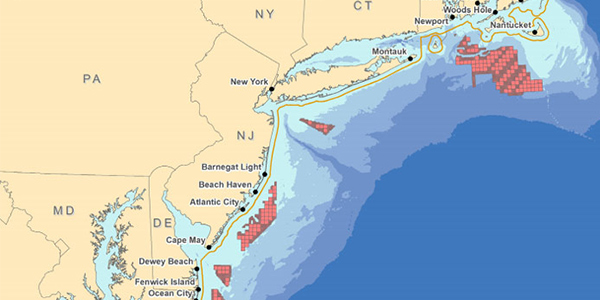The governors of Maryland, North Carolina and Virginia said Thursday they will collaborate to promote their states as a hub for the offshore wind industry.
The Southeast and Mid-Atlantic Regional Transformative Partnership for Offshore Wind Energy Resources (SMART-POWER) will seek to increase regulatory certainty, encourage manufacturing of components, reduce project costs through supply chain development and share best practices.
OSW can “drive economic development and job creation as well as reduce the emission of greenhouse gases and other harmful air pollutants,” the group said in a press release, citing Department of Energy estimates that the Atlantic Coast OSW project pipeline could support 86,000 jobs, $57 billion in investments and generate up to $25 billion in economic output by 2030.
Virginia (5.2 GW) and Maryland (1.2 GW) have pledged to build 6.4 of the 29.1 GW in OSW capacity targeted by East Coast states.
North Carolina has not made any commitments, although it issued a request for proposals this summer for a supply chain and infrastructure assessment that will include identification of necessary port upgrades in Wilmington and Morehead City.
North Carolina’s Clean Energy Plan notes that Avangrid Renewables is developing the Kitty Hawk Wind Energy Area, 24 nautical miles from Corolla, which the company says has capacity for 2.5 GW. The plan, issued in October 2019, followed Gov. Roy Cooper’s (D) 2018 executive order calling for GHG reductions of 40% from 2005 levels by 2025.
Cooper said the three-state agreement “allows us to leverage our combined economic power and ideas to achieve cost-effective success.”
Virginia Gov. Ralph Northam (D) said OSW will be “key to meeting the urgency of the climate crisis and achieving 100% clean energy by 2050.”
The states’ memorandum of understanding says they will coordinate to use their assets “such as deepwater ports and transportation infrastructure, top-tier universities and research institutions, and highly trained workforces to support the offshore wind industry and supply chain to efficiently develop along the Atlantic Coast.”
The states will create a leadership team of representatives from each state that will meet at least quarterly and report to the governors annually on their “activities, progress and future strategies.”
The MOU also says the states will seek to reduce administrative burdens on the industry “by clarifying, streamlining and aligning, where appropriate, state regulatory requirements” for construction of OSW projects.
They also will share best practices about regulatory processes, military compatibility, environmental protection, workforce training, public engagement, competing uses, and community and stakeholder interests, including those of fishermen and boaters.
The states also pledged to coordinate their communications with the U.S. departments of Commerce, Defense, Homeland Security and the Interior.
“An alliance between Maryland, North Carolina and Virginia balances offshore wind economic development more evenly across the East Coast,” said Liz Burdock, CEO of the Business Network for Offshore Wind. “The market is now too dynamic and requires such large-scale collaboration that no one state should go it alone; regional cooperation is a must as the industry begins a multibillion dollar buildout over the next decade.”
Laura Morton, the American Wind Energy Association’s senior director of policy and regulatory affairs for OSW, praised the agreement.
“By adding multistate coordination to their individual efforts, the three states will be able to move forward more efficiently to develop their infrastructure and local supply chains to unleash this brand new American energy industry and the jobs and investments that come with it,” she said.






